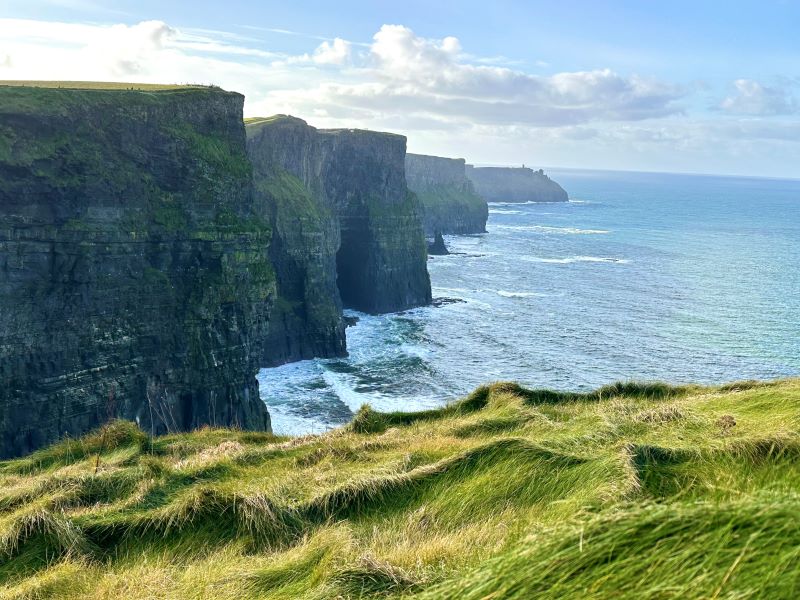Do you want to know interesting facts about Cliffs of Moher?
The Cliffs of Moher are among Ireland’s most visited landmarks. The annual number of people who come to marvel at this natural wonder is well over 1.5 million. The Cliffs of Moher is often regarded as one of those bucket-list destinations for anybody visiting Ireland.
While most people are aware of the Cliffs of Moher’s general appearance and formation process, there are many interesting details regarding the cliffs that others may be unaware of. What mechanism resulted in their formation? What is the length of the cliffs? And what does Moher mean as a name? Read on to learn more interesting facts about the Ireland’s most visited landmarks

Things you'll find in this article
- 1. The cliffs may be found on the west coast of Ireland, between the towns of Galway and Limerick, and are easily accessible by car.
- 2. The stunning cliffs are estimated to originate from the Carboniferous Period, which began about 320 million years ago.
- 3. The name Moher originates from the Gaelic language.
- 4. At Hag’s Head, the cliffs climb an impressive 120 meters (400 feet) above the ocean.
- 5. Many films, like “The Princess Bride” and “Harry Potter and the Half-Blood Prince,” have used the Cliffs of Moher as a setting.
- 6. The Cliffs of Moher’s highest point can be found at the O’Brien’s Tower lookout.
- 7. The cliffs, which stretch for around 5.5 nautical miles (8 kilometers), are home to several species of marine and terrestrial mammals, as well as a wide variety of birds.
- 8. During the spring and summer months, the cliffs are covered in stunning grasses and wildflowers.
- 9. The spectacular cliffs have always been a popular tourist destination.
- 10. Cliffs of Moher are Ireland’s most popular paid tourist attraction.
- 11. The Cliffs of Moher are the subject of a significant amount of local lore.
1. The cliffs may be found on the west coast of Ireland, between the towns of Galway and Limerick, and are easily accessible by car.
They are an important part of the well-known route known as the Wild Atlantic Way, which travels along the west coast of Ireland.
2. The stunning cliffs are estimated to originate from the Carboniferous Period, which began about 320 million years ago.

Cliffs Of Moher, Image by Christine Rogador
When ancient rivers in Ireland deposited sediments on the seafloor, those sediments eventually hardened into the sandstone, siltstone, and shale that make up the now-famous Cliffs.
The Cliffs of Moher are essentially the remains of enigmatic creatures whose tracks have been preserved in the rock for 320 million years. What we see now is a combination of rivers, muck, mountains, and continents clashing.
3. The name Moher originates from the Gaelic language.
It literally translates to “ruined fort.” The name “Cliffs of Moher” therefore refers to the crumbling cliffs that surround the old fort.
4. At Hag’s Head, the cliffs climb an impressive 120 meters (400 feet) above the ocean.
But they reach their full height of 214 meters (702 feet) just to the north of O’Brien’s Tower, which is located eight kilometers away.This part of the cliffs offers one of the most breathtaking panoramas in all of Ireland.
5. Many films, like “The Princess Bride” and “Harry Potter and the Half-Blood Prince,” have used the Cliffs of Moher as a setting.

Cliffs Of Moher, Image by Christine Rogador
Production of the latter took place in a marine cave that was located below some towering cliffs. However, Harry and Dumbledore are actually standing on a rock that is located in County Kerry at the time of the scene.
6. The Cliffs of Moher’s highest point can be found at the O’Brien’s Tower lookout.

O Brien Tower in Cliffs of Moher, Image by Christine Rogador
Sir Cornellius O’Brien, a local landlord and Member of Parliament, built the tower on the cliffs in 1835 as an observation tower for the English visitors who frequented the cliffs at the time: “strangers visiting the lovely landscape of this neighborhood.” It is reported that it was once used as a teahouse and that it contained a large round table with seats made of ironwork.
7. The cliffs, which stretch for around 5.5 nautical miles (8 kilometers), are home to several species of marine and terrestrial mammals, as well as a wide variety of birds.
It is estimated that they will come in the latter half of May and remain until the middle of July. If you want to view them in their native habitat, the best time to visit is June.
You can see them all along the cliff face. Watch for guillemots, razorbills, fulmars, peregrine falcons, kittiwakes, and more besides.
Paths and vantage points along the cliff faces are ideal for birdwatching during the nesting season when visitors can observe hundreds of puffins at once. Bringing binoculars is a must!
8. During the spring and summer months, the cliffs are covered in stunning grasses and wildflowers.

Cliffs Of Moher, Image by Christine Rogador
There is a good chance of seeing dolphins, whales, and seals when one is perched on top of the cliffs. A significant number of hares can also be seen on the premises, in addition to a herd of wild goats that make their home in the area close to Hag’s Head.
9. The spectacular cliffs have always been a popular tourist destination.
Evidence suggests that the top of these towering cliffs was utilized in the past as a watchtower, as well as a location for quarrying, fishing, and the gathering of bird eggs and feathers. This use of the area dates back to the 1st century BC.
Travel writers were primarily responsible for the expansion of tourism in the 16th century. When compared to the rest of Europe, fewer people choose to vacation in Ireland. However, trip journals written about Ireland beginning in the 1780s and continuing into the 19th century have been discovered, and they discuss how beautiful yet perilous the cliffs are.
10. Cliffs of Moher are Ireland’s most popular paid tourist attraction.

Cliffs Of Moher, Image by Christine Rogador
Even though a large number of people are under the impression that the Cliffs of Moher are Ireland’s most popular paid tourist attraction.
The Cliffs of Moher are ranked second on the list of Ireland’s most popular paid tourist attractions. Its number of annual visitors is just slightly higher than that of the Book of Kells and the Dublin Zoo combined.
It is not surprising that there are a great number of people who go there. Visits to this natural wonder are sure to be unforgettable experiences for people of all ages, especially those with a passion for photography and the natural world. It is impossible for over a million individuals every year to be mistaken about its gripping allure of it.
11. The Cliffs of Moher are the subject of a significant amount of local lore.
These tales are just as fascinating as the scenery that they accompany. The eerie and breathtaking scenery of the cliffs has inspired a wide variety of tales, including those involving underwater civilizations and a witch who falls in love with Cu Chulainn.
The following are some of the stories that have received the most attention:
The Tale of the Witch and C Chulainn
Mal, a witch, was madly in love with C Chulainn, a famed member of the Red Branch, the fighting band of the High King of Ulster. However, Có Chulainn did not return her feelings. Mal, unyielding, began to pursue C Chulainn across Ireland until she eventually fell to her death.
One could argue that Malbay was so named because her blood stained the rocks when she crashed into them.
Hag’s Head is the moniker given to the rocks because they are thought to resemble Mal’s profile.
The Mermaid of Moher
A local man fishing near the Cliffs of Moher once spotted a mermaid. He initiated a conversation, but his interest quickly shifted to her magical robe. During their conversation, the man snatched the cloak and hurried back to his residence.
The mermaid, who needed the man’s cloak to get back to the ocean, followed him back to his house, but she couldn’t locate it anywhere. The mermaid had little choice but to marry the guy, and she and he were expecting a child shortly. The mermaid, however, never forgot her magical garment.
Eventually, the mermaid found her cloak and swam back to the ocean when the man was away fishing. Neither he nor their children ever saw her again.
Eel, or Corpse-Eater
In the parish of Kilmacreehy, named after the Irish saint Macreehy, you’ll find the breathtaking Cliffs of Moher.
Macreehy supposedly took out a really large eel. Legend has it that an eel visited the cemetery near Liscannor for a meal. Macreehy killed the eel in an attempt to save his departed comrades.
Today when you visit the cliffs at low tide, you may see two stones purported to mark where the saint slept. There used to be a stone at Kimacreehy with a carving of an eel on it, but now it’s been removed.
Book your tours here.

Hi, I’m Christine – a full-time traveler and career woman. Although I’m from the Philippines, my location independent career took me to over 60 countries for the past 12 years. I also lived in 4 continents – from the Caribbean, South East Asia, Africa and now in Europe. But despite living in several countries, my love for Ireland remains the same. A country that had been a part of my life since I was 14 because of my love for Irish music and bands. Ireland Travel Guides was born because of this passion and hopefully, in some little ways, this website will be able to help you on your next trip to Ireland.